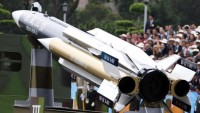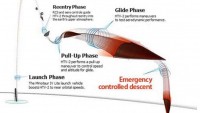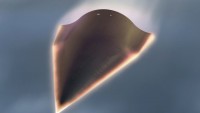Development of World’s Most Heat Resistant Material makes Possible Manned Hypersonic Aircraft
| Arthur Dominic Villasanta | | Dec 26, 2016 04:42 AM EST |
(Photo : Boeing) U.S. Air Force X-51 Waverider hypersonic missile (illustrationj).
The discovery by researchers at the Imperial College London of materials that can withstand an incredible 4,000 degrees Celsius opens the door to more applications involving protection from extreme heat, including manned hypersonic aircraft and spacecraft.
The temperature at the surface of the Sun is 5,500 degrees Celsius, a factoid that shows how heat resistant these materials are.
Like Us on Facebook
Researchers discovered that the ability of tantalum carbide (TaC) and hafnium carbide (HfC) materials to withstand extreme heat means refractory ceramics can be used in thermal protection systems on hypersonic vehicles travelling in excess of Mach 5 or 6,200 km/h.
Tantalum carbide and hafnium carbide are refractory ceramics, meaning they are extraordinarily resistant to heat. Researchers discovered that the melting point of hafnium carbide is the highest ever recorded for a material.
Hypersonic cruise missiles armed with warheads such as those being developed by the U.S. Air Force can hurtle towards their targets at Mach 5, and can be fired further away from their targets. At these fantastic speeds, a hypersonic missile can jet from Los Angeles to Beijing in less than 1.5 hours.
Researchers developed a new extreme heating technique using lasers to test the heat tolerance of TaC and HfC. They used the laser-heating techniques to find the point at which TaC and HfC melted, both separately and as mixed compositions of both.
They found that the mixed compound (Ta0.8Hf0.20C) was consistent with previous research, melting at 3905°C, but the two compounds on their own exceeded previous recorded melting points. The compound TaC melted at 3768°C and HfC melted at 3958°C.
Researchers said the new findings could pave the way for the next generation of hypersonic vehicles, which means these aircraft will become faster than ever.
"The friction involved when travelling above Mach 5 -- hypersonic speeds -- creates very high temperatures," said Dr. Omar Cedillos-Barraza, an Associate Professor at the University of Texas - El Paso whocarried out the study while doing his PhD at Imperial's Department of Materials.
"So far, TaC and HfC have not been potential candidates for hypersonic aircraft, but our new findings show that they can withstand even more heat than we previously thought -- more than any other compound known to man.
"This means that they could be useful materials for new types of spacecraft that can fly through the atmosphere like a plane, before reaching hypersonic speeds to shoot out into space. These materials may enable spacecraft to withstand the extreme heat generated from leaving and re-entering the atmosphere."
Other potential uses for TaC and HfC could be in the re-entry shields for spacecraft, and in external instruments that have to withstand the most friction during flight.
Hypersonic aircraft traveling at Mach 5 or above currently don't carry people, but Dr. Cedillos-Barraza suggests this might be possible in the future.
"Our tests demonstrate that these materials show real promise in the engineering of space vehicles of the future. Being able to withstand such extreme temperatures means that missions involving hypersonic spacecraft may one day be manned missions.
"For example, a flight from London to Sydney may take about 50 minutes at Mach 5, which could open a new world of commercial opportunities for countries around the world."
TagsImperial College London, tantalum carbide, hafnium carbide, hypersonic space vehicles, Dr. Omar Cedillos-Barraza
©2015 Chinatopix All rights reserved. Do not reproduce without permission
EDITOR'S PICKS
-

Did the Trump administration just announce plans for a trade war with ‘hostile’ China and Russia?
-

US Senate passes Taiwan travel bill slammed by China
-

As Yan Sihong’s family grieves, here are other Chinese students who went missing abroad. Some have never been found
-

Beijing blasts Western critics who ‘smear China’ with the term sharp power
-

China Envoy Seeks to Defuse Tensions With U.S. as a Trade War Brews
-

Singapore's Deputy PM Provides Bitcoin Vote of Confidence Amid China's Blanket Bans
-

China warns investors over risks in overseas virtual currency trading
-

Chinese government most trustworthy: survey
-

Kashima Antlers On Course For Back-To-Back Titles
MOST POPULAR
LATEST NEWS
Zhou Yongkang: China's Former Security Chief Sentenced to Life in Prison

China's former Chief of the Ministry of Public Security, Zhou Yongkang, has been given a life sentence after he was found guilty of abusing his office, bribery and deliberately ... Full Article
TRENDING STORY

China Pork Prices Expected to Stabilize As The Supplies Recover

Elephone P9000 Smartphone is now on Sale on Amazon India

There's a Big Chance Cliffhangers Won't Still Be Resolved When Grey's Anatomy Season 13 Returns

Supreme Court Ruled on Samsung vs Apple Dispute for Patent Infringement

Microsoft Surface Pro 5 Rumors and Release Date: What is the Latest?














